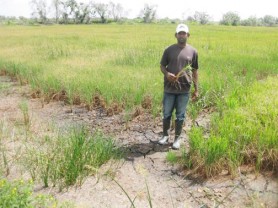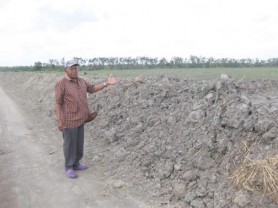Cash crop farmers in the Mahaica Creek are moving from bounty to bare as the relentless El Nino phenomenon bakes their plots and rice farmers are not far behind as their already limited access to water continues to dwindle.

When Stabroek News visited the area on Thursday, cash crop and rice farmers had tales of woe.
They said the water in the Perth/Biaboo canal had reached an extremely low level and was not enough to pump into their fields.
The Mahaica-Mahaicony-Abary/Agricultural-Development-Authority (MMA/ADA) had blocked four canals leading to the creek, one month ago, “to help the Perth/Biaboo canal to get back fresh water” and for farmers to access it for their crops. Because of the critical nature of the situation, the farmers were still allowed to use the water without seeking permission from MMA officials. At one stage, they said, only the farmers from the “outer end” of the creek with early-stage rice were given priority to pump. An official from the Ministry of Agriculture told this newspaper yesterday that the level of the water in the canal has risen.
Following a meeting in the area on Tuesday afternoon with officials of MMA, including Chairman Rudolph Gajraj and General Manager Aubrey Charles with the farmers, they are now being allowed several hours each of pumping.

While some farmers are grateful for the water some of the large-scale farmers said it is still not adequate for their crops. They claimed that the creek was taking in saltwater because “the fresh water from the creek was being pumped into the East Demerara Water Conservancy.”
According to them, “they [the authorities] neglect the farmers. In the rainy season they turn the system around; they release water from the conservancy into the Mahaica and Mahaicony creeks. Now in the dry weather they taking water out of here and it is affecting the rice, cash crop and cattle farmers.”
Large-scale rice farmer, Shamshumdar Ramroop, 29, of Little Biaboo said he invested in 300 acres of rice and has lost about $2.5 million because “35 acres went down the drain due to the limited water. It had a little water in the system but MMA stop me from pumping.”
He said he was able to access water when he planted the crop and applied the first dose of fertiliser in December. However, no water was available “when the rice reached the bearing stage and was ready for the second dose of fertiliser.”
Ramroop showed this newspaper some of his other rice fields that were blooming and said one plot would be ready for harvesting in two days. Another farmer, 80-year-old Shameer Hussain told this newspaper that Ramroop is assisting him to farm on a 65-acre plot but MMA has blocked the access to his field with mud that was dug out from the Perth/Biaboo canal.
He said too that MMA had removed a 28-ft tube leading from the canal to his rice field.
Hussain said Ramroop got permission from an official (name provided) from MMA to go ahead and replace the tube.
Ramroop said he installed a tube-37 ft. in length which cost him $157,000. Admitting that there was no written permission, he said MMA later came and seized his tube.
MMA officials have promised to return the tube, which is currently at their camp in the backdam but the farmer is afraid that it may be damaged.
Another farmer told this newspaper his 70-acre rice farm was at a critical stage and needed water a few weeks ago. He has only now received permission to irrigate his field and has invested a lot more money doing so with a tractor pump in a desperate bid to save his crop.
However, he may “not get much” from his crop because it is too late now for the water. He also has another field with “bigger” rice and is preparing to harvest it in three weeks. Fazal Hussain, 52, has only invested in eight acres of rice this crop. He said he planted it in January and was able to pump water into his field then. The rice needs water again and if he cannot get to pump it in time he may lose the crop.
Cash crop and livestock
Cash crop and livestock farmers of Little Biaboo and Big Biaboo told this newspaper that they have been affected because of the brackish water in the creek.
A cash crop farmer said he “cannot do much farming because the trench drying out. Ah waiting on the rain to plant again.”
Another farmer who was reaping her bora when this newspaper visited said “the water very hard to get now.” She is afraid that soon all her plants would die, although she has not reaped the amount she was expecting.
Besides, she is just being paid $300 for a huge bundle of the vegetable which used to be sold for of $600.
Bhagwan Persaud of Little Biaboo told this newspaper that he had invested in 3,000 roots of bora, four acres of tomatoes and six acres of watermelon but “right now we na get no kinda water.”
He said he was forced to abandon a few fields of tomatoes and watermelon because they did not grow properly. He said some of the watermelons were “white inside” while in the case of the tomatoes, although they appeared to be ripe they were actually hard on the inside.
Another farmer, Mohanlall Sukhram, who retired as a headmaster last February said because of the dry weather he would not get the full amount of produce “but I cannot blame anyone…” He said the water from the creek is too “heavy” and that would result in the reduction. Out of the 2,500 roots of bora he planted he has had to abandon over 1,000 roots and may just reap about 500 bundles. He has reaped about 400 bundles so far. He pointed out that his tomato crop was flourishing “but there is a glut in the market and I am not getting a good price… right now the vendors at Bourda market paying just $30 per pound.”
The farmers said too that their cattle and other livestock are punishing because the grassland has been dry and the animals do not drink the saltwater in the creek. Some of the farmers had reserved water in ponds for the animals though, but they have had to incur extra cost for bran and molasses.
The residents said they depend heavily on rainwater and water from the creek for drinking and cooking purposes and they have already run out of supplies. They said the Guyana Water Inc was supplying water to some areas, while some residents said they were paying $3,000 for a 450-gallon tank.





